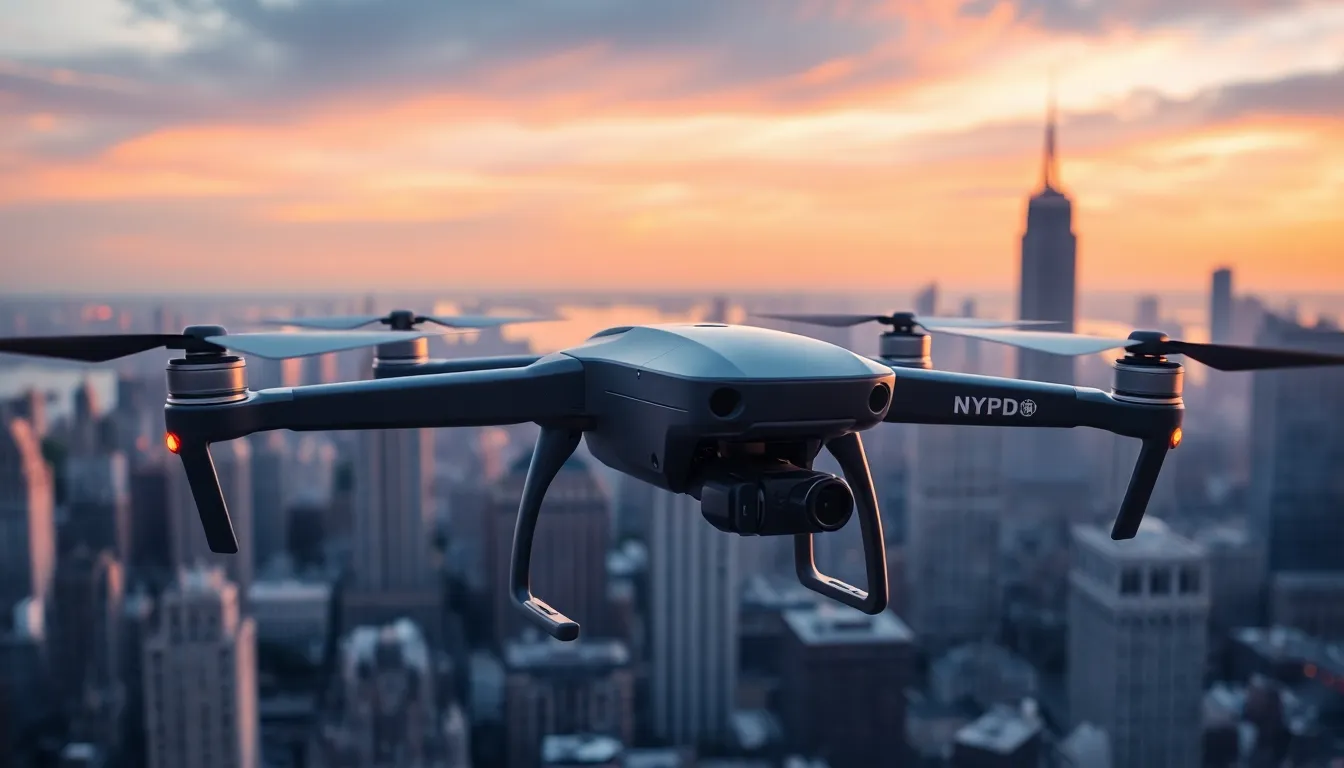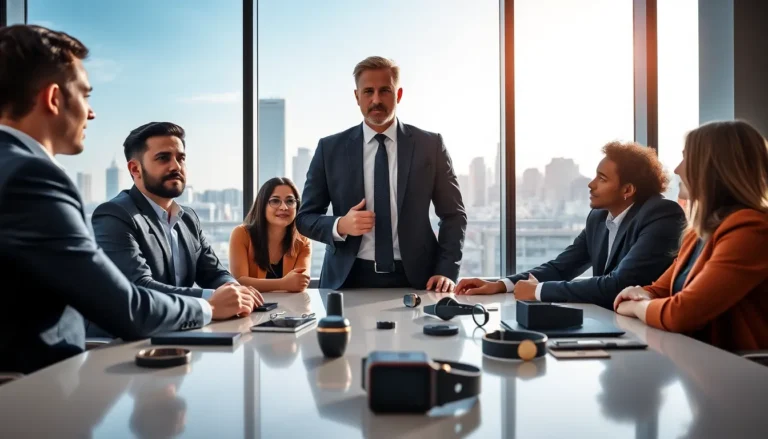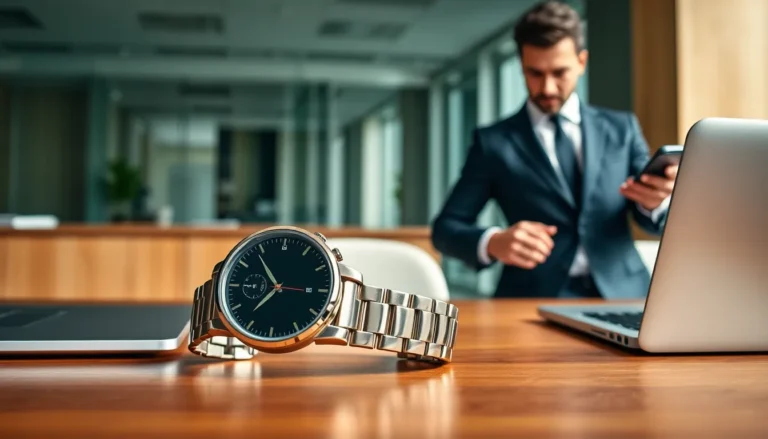In the bustling streets of New York City, where every corner has a story and a slice of pizza is never too far away, the NYPD is taking to the skies. Drones are no longer just for tech enthusiasts or the occasional backyard filmmaker; they’re now a key player in urban policing. Imagine a bird’s-eye view of the city, where crime-fighting meets cutting-edge technology, all while avoiding the traffic jams below.
Table of Contents
ToggleOverview of NYPD Drones
NYPD drones play a crucial role in modern urban policing. These devices enhance situational awareness and provide real-time information during critical events in New York City.
Purpose and Objectives
NYPD drones serve multiple purposes. They assist in monitoring large public gatherings, offering aerial views that improve safety. Crime scene investigations also benefit from drones, allowing detectives to survey areas from above. Accessing hard-to-reach locations becomes easier through the use of UAVs (unmanned aerial vehicles). Additionally, drones aid in search and rescue missions, helping locate missing persons quickly. NYPD’s objectives include increasing efficiency, enhancing public safety, and gathering evidence in a more effective manner.
Historical Context
The inception of NYPD drones reflects a broader trend in law enforcement. In 2015, NYPD began exploring drone technology, marking a significant shift in policing methods. Initial trials focused on evaluating the devices’ effectiveness in various scenarios. By 2017, the NYPD implemented drones more widely, responding to emergencies and assisting in crime scenes. Regulations surrounding drone usage developed concurrently, addressing privacy and safety concerns. Continuous advancements in drone capabilities have further integrated this technology into urban policing strategies.
Technology Behind NYPD Drones

NYPD drones represent a significant advancement in urban policing, leveraging cutting-edge technology to enhance law enforcement operations.
Types of Drones Used
Various drones play crucial roles in NYPD operations. The department uses small quadcopters for tactical missions. Larger fixed-wing drones assist in surveillance over vast areas. Specialized drones, such as those equipped with thermal imaging, help locate missing persons during search and rescue operations. Each type serves distinct needs, enhancing pilots’ operational flexibility and effectiveness during critical situations.
Features and Capabilities
These drones come with advanced features essential for law enforcement work. High-resolution cameras provide detailed imagery, aiding in crime scene documentation. Real-time video feeds allow officers immediate access to live situations, improving response times. Some drones support autonomous flight, enabling officers to focus on other tasks. GPS technology enhances navigation accuracy, ensuring consistent coverage across New York City’s diverse environments. The integration of these capabilities contributes to safer and more efficient policing efforts.
Applications of NYPD Drones
NYPD drones serve multiple critical functions in law enforcement. They enhance operations through advanced aerial technology.
Crime Scene Investigation
Drones provide invaluable assistance in crime scene investigations. Equipped with high-resolution cameras, these drones capture detailed images, aiding in the collection of evidence. They can access difficult locations that may be unsafe or challenging for officers. Real-time video feeds offer immediate insights into crime scenes. NYPD utilizes drones to document evidence from various angles, ensuring thorough analysis. This capability significantly reduces the time needed for investigators to complete assessments.
Search and Rescue Operations
Search and rescue missions benefit immensely from drone technology. Drones can cover large areas quickly, identifying individuals in distress. Thermal imaging capabilities enable quick detection of heat signatures, even in low-visibility conditions. NYPD employs drones for efficient coordination in urban environments, contributing to life-saving efforts. Real-time video feeds allow responders to assess situations and devise effective rescue strategies. These operations highlight the drones’ critical role in enhancing public safety during emergencies.
Public Safety and Crowd Management
Drones play a vital role in public safety and crowd management. During large events, NYPD uses drones to monitor crowds from above, providing a comprehensive view of the situation. Surveillance data helps identify potential issues before they escalate, allowing for swift intervention. Drones assist in maintaining order during parades or protests by offering situational awareness to ground units. The integration of drones into crowd management enhances the NYPD’s ability to ensure safety for all attendees, serving as a proactive measure.
Controversies Surrounding NYPD Drones
Concerns surrounding the use of NYPD drones frequently arise, particularly focusing on privacy and community responses.
Privacy Concerns
Privacy concerns dominate discussions about NYPD drone usage. Critics argue that widespread surveillance may infringe on citizens’ rights, creating a chilling effect in public spaces. Additionally, there’s anxiety over data collection and storage, leading to potential misuse. The absence of strict regulations has led to calls for clearer policies regarding surveillance limits. NYPD’s drone operations are subject to scrutiny, especially with regards to how footage is monitored and utilized. Advocates for privacy emphasize the need for transparency in these practices to safeguard citizens’ personal information. This tension between security measures and privacy rights continues to evolve as drone technology becomes more pervasive.
Community Reactions
Community reactions to the deployment of NYPD drones vary significantly. Many residents appreciate enhanced safety during public events, feeling reassured by the aerial oversight. Conversely, a segment expresses wariness regarding constant monitoring, fearing its implications for freedom. Neighborhood organizations often vocalize concerns, framing drone surveillance as a potential step towards a police state. Some grassroots groups advocate for increased conversations between the NYPD and community members to address these issues. As drone operations expand, ongoing dialogue remains critical to balancing security and residents’ civil liberties.
Future of NYPD Drones
The future of NYPD drones looks promising as technology continues to evolve.
Potential Developments
Innovations in drone technology may lead to more advanced features. Upcoming models could integrate artificial intelligence for enhanced decision-making during critical incidents. Increased battery life is another expected improvement, allowing drones to operate for extended periods without recharging. Multisensor capabilities may also emerge, providing real-time data on various environmental factors. Regulations surrounding drone operations might tighten, addressing privacy concerns and ensuring community safety while maintaining effectiveness.
Impact on Law Enforcement
The incorporation of drones into law enforcement operations offers numerous advantages. They can significantly shorten response times, aiding officers in reaching remote locations during emergencies. Enhanced surveillance capabilities provide law enforcement with real-time insights, allowing for immediate tactical adjustments. Drones also promote improved situational awareness, assisting in strategic planning during large events. Their contributions may lead to stronger community relationships, fostering trust through transparent operations and engagement with residents. Ultimately, these advancements create transformative shifts in how the NYPD approaches modern policing challenges.
The NYPD’s integration of drones marks a significant shift in urban policing. These advanced tools not only enhance situational awareness but also streamline various law enforcement operations. As technology continues to evolve the potential for improved community safety and engagement grows.
Balancing the benefits of drone usage with privacy concerns remains essential. Ongoing conversations between the NYPD and community members will play a crucial role in shaping the future of drone applications in policing. The path forward holds promise for a more efficient and responsive law enforcement approach, ultimately redefining how safety is managed in New York City.


